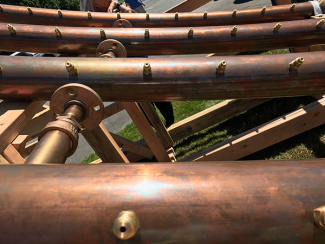Tivoli Fountain restoration and modernization project nearing completion
Work to overhaul the Tivoli Fountain's operational systems is nearing the final stretch. When finished, the fountain will use less energy and less water, and require less maintenance.
Enterprise Services expects the popular Capitol Campus attraction to re-open in late summer. Once a final completion date is known, the agency will schedule a re-opening ceremony.
Long-term savings
The fountain improvements are designed to reduce water and energy use, reduce maintenance needs, and improve operational efficiency. For example, the original fountain operated with an approximate 27,800 gallon water capacity. With modernization, the capacity is approximately 19,000 gallons -- a 32 percent reduction in the volume of water needed to operate the fountain.


Completed work includes:
- Installation of the massive "spray ring" in the fountain's outer basin is occurring now. The gigantic 50-foot diameter "spray ring" had to be specially fabricated for the fountain. Production of the ring is almost complete. Shaped like a giant hula-hoop, the spray ring is perforated with 272 individual nozzles that throw streams of water from the outermost edges of the fountain up and into the center ring, forming the umbrella of water that is a featured characteristic of the Tivoli Fountain.
- Removal and replacement of the fountain's concrete basin floors is complete. The new basin floors are set significantly higher so that the fountain will require approximately one-third less water to fill and operate.
- The fountain's piping has been redesigned and replaced, including the piping inside the basins, drain lines, and supply and return lines that run to and from the pump house. The choreography of the water movement will look the same as ever, but the fountain will operate with much greater efficiency.
- Sculptural copper baskets were re-installed.
- Updates to the fountain's electrical system are complete.
Remaining work includes:
- Landscaping immediately around the fountain basins, replanting of grass, and clean-up of the construction site is underway.
- A vault is being installed adjacent to the pump house that will house a new filtration system, minimizing maintenance requirements and adding longevity to the entire system. With this addition to the project, a second phase of fountain repairs originally planned for 2019 will be avoided, and the filtration system will be installed at one-third the cost.
- Final assembly and installation of nozzles and lighting is underway. Old lighting is being replaced with new, energy efficient LED lighting.
Additional improvements
In addition to the many functional improvements:
- The bronze dedication plaque has been cleaned and polished.
- The nearby historic drinking fountain, the last of its kind on the campus, has been repaired and restored.
- The sidewalks around the fountain have been restored to match surrounding historic sidewalks.
- Decorative plantings have been restored in a bed of mixed annuals and perennials encircling the fountain, selected to provide year-round color.
Challenges encountered during the project include record wet weather this spring as well as unanticipated underground discoveries during construction, including abandoned pipes, valves, conduits and concrete vaults. Contractors also needed to install new electrical and water conduit.
In addition, the fountain will re-open without its original iron picket fence. While care was taken to protect it during construction, the discovery of lead-based paint led to a public-safety decision to remove it. The fence has been stored for possible treatment and re-installation in the future. An existing concrete curb and landscape plantings that encircle the fountain are expected to deter visitors from approaching the fountain's basins.
"When working to upgrade structures as old as this one, it is common to discover issues such as these," said Bill Frare, Facility Professional Services director at Enterprise Services. "It's important to pause and address them to ensure the repairs are durable and achieve their energy efficiency objectives."